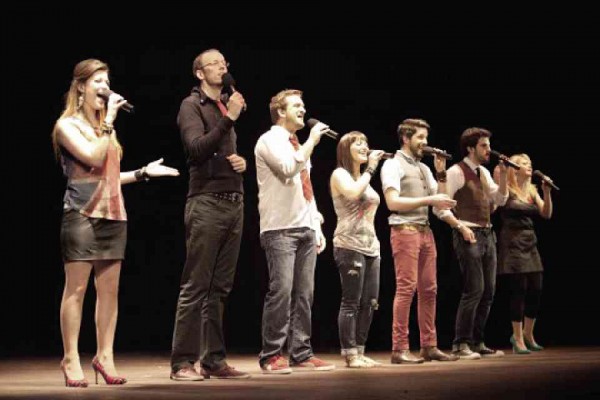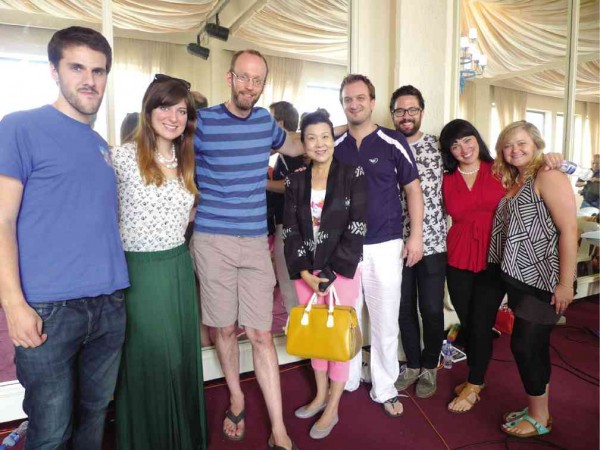In full swing
Good classical music groups rarely come to town even though our neighbors Hong Kong, Taiwan and Singapore get a fair share of visits from the most famous orchestras, opera singers and choirs.
Thanks to the Philippine Madrigal Singers and the Philippine Choral Directors Association, the Swingle Singers obliged us with a visit recently.
The original Swingles was an a cappella group formed in Paris in 1963, making this season their 50th anniversary. Now based in London, the current Swingle Singers consists of seven young and versatile singers whose voices can be pushed to do anything—including singing percussion.
Observing the Swingles up close and chatting with them during the two-day workshop they gave at the Cultural Center of the Philippines allowed me to learn how they work in full swing.
I learned not only about music. I also learned about leadership, respect, responsibility, creativity, diversity, freedom and community.
Article continues after this advertisementFor instance, while waiting for dinner to be served on Friday, I wanted to interview the leader of the group. But who was the leader? Nobody could say for sure.
Article continues after this advertisementIndeed, all seven singers in the ensemble lead and follow. There are those who compose and arrange music and those who help in marketing, but rehearsals are done round robin, with one person assigned for a period of time.
Music geniuses
All seven of them are music geniuses at par with each other. No one is upstaged by another and no one threatened by the other one.
During the three-hour workshop for choral conductors and choir members, each Swingle singer led an activity while the rest joined the mostly first-time participants. No one sat by, waited or made excuses for other important preparations.
They seemed to come up with new ideas, even as they participated excitedly in the activities conducted by a fellow singer. No signs of boredom for them, none of the “been there, done that” syndrome common to longtime “experts” or work partners.
One would expect a choral workshop to be a place where a lot of vocalization and conducting techniques are shared. As it happened, this one was not content with mild stretching or gentle humming.
First, every bone and muscle had to go through extreme stretching and contortion to make the “smallest toe sing well.” Exercising your lungs means speeding up singing “many men” to the tune of Rossini’s “William Tell Overture”—preferably in one breath.
Some “foolish” activities were introduced to take away the fear of failure and embolden the musicians.
Volunteers were called and cajoled into the circle or the “lion’s den.” The first mission was to invent a tune, all six people at the same time; eventually, a more dominant tune emerged while the others were harmonizing it.
Next, singers were paired off and asked to face each other to spontaneously create a new tune. A third singer joined in to form a trio, and another and another, until a full choral piece was formed.
How about the whole class singing a canon about to be created? That was perfectly possible with the 70 participants, even as the composition for four sections was still evolving.
Everyone can learn to be a diva at the drop of a pin. Randomly given a sheet of paper (incidentally with words introducing the Swingle Singers), a group of five volunteers was tasked with composing and singing an aria. Just like that, and you heard the most glorious sound on a nice swell of belle canto.
Much awaited
The evening of the workshop days brought the much-awaited concert “Two for the Gold: Two Legends.”
If there was one concert I would not have missed this year, this was it. Just like the Swingle Singers, our very own Madrigal Singers was celebrating their 50th anniversary this year. And just like the Swingle Singers, the Madz has grown and multiplied. Long live choral singing!
I have always been proud of the Madz, having watched them here and abroad. They would always receive such a warm reception and thunderous applause that you wished every Filipino would get a chance to hear them and feel that sense of pride.
But on this night, compared to the Swingle Singers, the Madz looked stiff and standoffish, seated in their famous circle and dressed
in their finery. They sounded serious throughout the repertoire, even with the
music that was supposed to be fun, and “It Might Be You”
was seriously slow. Still,
they managed to maintain the unmistakable choral sound that every other choral
group in the Philippines
wants to imitate.
The Swingle Singers sauntered in dressed in relaxed, casual outfits. In different combinations of black and white with red accents, their opening number, “Weather to Fly,” was so effortless and without fanfare but effective.
Their repertoire was a good mix of classical, jazz, Latin, folk and pop music, much of which had been composed or arranged by the Singers themselves. The younger set in the audience loved Beyonce’s “Single Ladies” and Alanis Morissette’s “You Oughta Know.” I loved Corelli’s “Concerto Grosso” and Donizetti’s “The Diva Aria.”
One song flowed seamlessly to the next without any effort of divining the pitch or deciding the beat. The easy pace and smooth transitions made the listening both exciting yet not overwhelming.
My favorite in this concert was “Claire de Lune” by Claude Debussy, as arranged by the founder, Ward Swingle. The high pitch for the treble came as easy as the flow of the bass clef, like a left hand playing on the piano.
Another piece that made me misty-eyed was the encore of the Visayan (Ilonggo) lullaby, “Ili-ili Tulog Anay.” The way the Swingle Singers transposed it from one key to another with different voices coming in at different junctures brought a rich layer of textures and musical effects.
It is not an exaggeration for me to say that throughout the evening, I was as fascinated as a child lost in wonder on her first visit to Disneyland.
Indeed, what minds could conceive, their voices have achieved.
The author is an associate professor of educational psychology at the University of the Philippines College of Education. E-mail [email protected].

